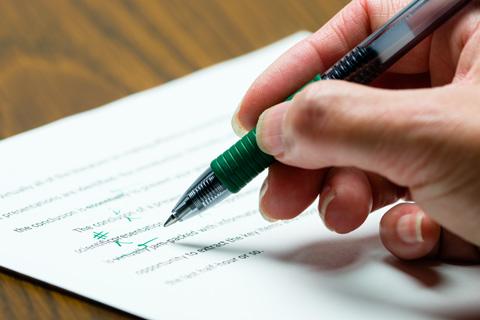By Ken Michaels, Guest Writer
The following are actual headlines from local, national, and international newspapers*:
Kids Make Nutritious Snacks
Astronaut Takes Blame for Gas in Spacecraft
Grandmother of 8 Makes Hole in One
Lack of Brains Hinders Research
All of these are ambiguous, that is, they can be read to mean at least two different things. I have occasionally wondered if headline writers do this intentionally, perhaps to amuse the well-educated reader or perhaps to see if they can slip something by a senior editor.
But if it’s not deliberate, the publishers of these gems have likely fallen victim to a common wrong turn along the pathway to clear communication: failure to proofread.
If we can assume, for example, that the author of one of the above headlines merely sought to congratulate a senior citizen for a perfect drive in the game of golf, a careful proofreader would probably have noted that the headline also suggests that she’s perforated one of her grandkids.
Saying exactly what we mean often requires real concentration, especially when we’re writing something that we intend to be read by others. And sometimes, when we think we’ve written exactly what we mean, we haven’t. We’ve likely made any number of errors, some of which can be hard to spot. Errors in syntax, grammar, and even spelling creep into our writing, leaving us open to misinterpretation, or even embarrassment.
Worse yet, failure to proofread sometimes translates into time and money—because if we don’t catch mistakes in the “proof,” we may have to spend a lot of time fixing an error found after the fact, or a lot of money for do-overs at the printer.
That’s why it’s so important that, before sending our work out for public display, we make sure it is very carefully proofread. Always.
A Second Set of Eyes
Proofreading is a term (and a tool) used throughout the printing industry: a printer sends the customer a sample, or “proof,” to review, or “read,” before the piece is printed in multiple quantities.
Once the proof is approved, the printer sets the process in motion. Errors that are not caught on the proof will go on to be reproduced many times over.
That’s why it’s incumbent on the customer, or the person who is reading and approving the proof, to be absolutely sure that everything—down to the commas and periods—is exactly how he or she wants it to be.
Of interest is that it’s much easier to spot errors in the work of others than it is in our own. That’s why an axiom in publishing is that the best job of proofreading is performed by someone other than the author. The author knows what is meant by a sentence he or she wrote, but the question is, does the reader actually get the same meaning from it?
The so-called “second set of eyes”—another person who reviews a document—is more likely to spot various problems with how the document reads or pick up technical errors, like spelling and punctuation.
Tips for Proofreaders
If you are asked to proofread a document, or if you are given a proof to approve before printing, here are some tips to help you spot corrections that need to be made:
- Make a checklist of elements to review, and concentrate on a single element at a time. If you’re looking at the document as a whole, you’re more likely to miss things. But if, for example, you read through all the main headings at once, then all the subheadings, then the table of contents and the page numbers, then the main text, and so on, you’re far more likely to spot errors.
- If you have time, take a break between reviews in order for each one to get a fresh look.
- Try reading aloud to yourself. This will help you identify sentences that are too long or phrases that are awkward, in addition to finding misspellings or incorrect punctuation.
- Proofread with another person. One person reads aloud what’s supposed to be there (what was sent to the printer, for example), including not just the text, but all the punctuation, capitalization, font treatment (boldface, italics, etc.), paragraphing, and so forth, while the other one follows along on the proof. With this team approach, you’re more likely to catch mistakes than if you were just proofing on your own.
- Read in reverse order. This is probably the best way to spot misspellings, because when reading backward, you’re not distracted by the context of what you’re reading; you’re giving each word individually a careful look.
And probably the most important of all tips about proofreading is: always do it!
Good written communication is a challenge in itself. Seasoning your prose with unintentional errors in grammar, voice, spelling, and such only complicates it. Proofreading will make your document more professional, save you time, and, in some cases, even save you money.
© 2014 Ken Michaels. All rights reserved.
- http://www.fun-with-words.com/ambiguous_headlines.html, accessed January 7, 2014.
Ken Michaels, retired manager of Visual Communications, Leidos Biomedical Research, is a special volunteer for NCI at Frederick.


